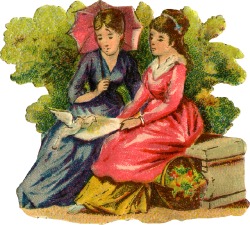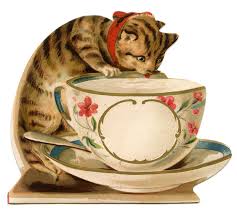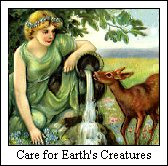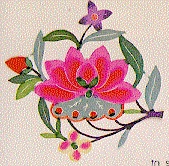|
|
 |
Miss Stacy is ready to share this lore with comments on gardening, home remedies, and making the most of what one has. She was reared with the slogan:
 Old Wives are made, not born. Miss Stacy has reached the status of "Old Wifeness" by listening to her elders (of whom very few remain), by observing nature and human nature, and by applying an abundance of Mother Wit.
Old Wives are made, not born. Miss Stacy has reached the status of "Old Wifeness" by listening to her elders (of whom very few remain), by observing nature and human nature, and by applying an abundance of Mother Wit.
Use it up;
Wear it out;
Make it do, or do without.

When to Plant
30 March 2014 Knowing when to plant is of greatest interest to gardeners, and it is a concern to which Old Wives pay great attention. Miss Stacy, who had the advantage of learning from Old Wives born in the Nineteenth Century, was taught that one does not plant until the soil is warm. Great! But how is that determined?
Knowing when to plant is of greatest interest to gardeners, and it is a concern to which Old Wives pay great attention. Miss Stacy, who had the advantage of learning from Old Wives born in the Nineteenth Century, was taught that one does not plant until the soil is warm. Great! But how is that determined?
Simple, really. The soil is warm enough for planting when one can sit — bare bottomed — on it and count to one hundred. If there's concern that the neighbors might object, one can always check with the Department of Agriculture which produces maps of hardiness zones and recommends dates for planting.
Planting by the moon has an abundance of lore. Plant when the moon is waxing, and the plants will grow as the moon grows, taught Miss Stacy's grandmother. Others say that when planting root crops, plant during the darkening of the moon; when planting crops harvested for above-ground growth, plant when the moon is growing.
Many old-timers get more detailed and plant specific crops when the moon is in a specific sign. This requires purchase of an Almanac that references signs of the zodiac and parts of the body. Plow, till, and cultivate in Aries. Set out plants in a water or earth sign. Don't plant potatoes when the sign is in the feet. Plant beans when the signs are in the arms. And much, much more.
Planting by signs seems tiresome to Miss Stacy who prefers to graft her indoor African Violets whenever the mood strikes and to set annuals outdoors the second weekend in May. (She lives in Maryland.) She does not comment on how she determines the soil is warm enough to plant seeds.

Weather Signs
23 March 2014 Weather is a topic which every adult on this planet comments on every day. Farmer or factory worker, chef or clerk, we are affected by the weather. How to dress, whether our gardens will thrive, rises in food prices, how sad or cheerful we feel.
Weather is a topic which every adult on this planet comments on every day. Farmer or factory worker, chef or clerk, we are affected by the weather. How to dress, whether our gardens will thrive, rises in food prices, how sad or cheerful we feel.
Not surprisingly, weather lore is abundant.
You probably know
But do you knowRed skies at night, sailor's delight.
Red skies in morning, sailors take warning.
orIn the decay of the moon,
A cloudy morning bodes a fair afternoon.
When clouds appear like rocks and towers,
The earth's refreshed by frequent showers.
Rhymes are easy to learn and fun to recall, but most weather lore exists in prose format. Here are but a few of the myriad known to Miss Stacy.
- Cattle huddle at one end of the pasture before a storm.
- If flies swarm into the house, expect a storm.
- Bees stay near the hive when bad weather is on the way.
- Snails are numerous when rain is on the way.
- Two full moons in a month bring heavy rains.
Other indicators include forecasting weather by plants. It will be a bad winter if,
- Carrots grow deeper.
- Sweet potatoes have tougher skin.
- Trees have green leaves late into Fall.
- Leaves shed before they turn color.
- Pine cones open early.
- The darker green the grass during the summer, the colder the winter.
It is commonly held that a long, hot summer means a long, cold winter. The number of days old the moon is at the first snowfall tells how many snows there will be that winter. If it rains on Easter Sunday, it will rain the next seven Sundays. The first twelve days after Christmas indicate what each month in the new year will be like.

Hummingbirds
16 March 2014The sight of a hummingbird is a major cause of smiles. Smallest of birds, these "flying jewels" enchant us as they flit from flower to flower flying forward, flying backward, hovering, and occasionally perching on a twig.
Hummingbirds are specific to the Western Hemisphere. Miss Stacy cannot resist sharing a bit of what she knows about these joy-bringing birds.

Hummingbirds take nectar from flowers and from sugar water in feeders. They also eat small invertebrates such as fruit flies, gnats, aphids, spiders, maggots, and others small enough to swallow.
Hummingbirds don't form pair bonds; they only come together to mate. The female builds a cup-shaped nest of thistle and dandelion down or similar soft, downy material. There usually are two eggs per clutch, and females most commonly lay two clutches per year. The egg of a ruby-throated hummingbird is barely half an inch long.
It is the ruby-throated species that visits Miss Stacy's yard to enjoy the nectar from the red trumpet vine and hosta blossoms from mid-July until shortly after Labor Day. Most birds are female; the males migrate in July. Ruby-throated hummingbirds are nocturnal migrators. Most of the ruby-throated birds migrate from the East Coast across the Gulf of Mexico to the Yucatan Peninsula each spring and fall. They migrate singly, not as a group, although radar tracking has found that individuals will join groups of other species in their migration.
Hummingbirds are attracted to gardens with lots of flowers, especially trumpet-shaped ones near the red end of the spectrum. Their likes include trumpet vines, nasturtiums, columbines, bee balms, scarlet sages, and gladioli. They will come to nectar feeders, and many hummingbird feeders are available commercially.
Companies sell nectar mixes, or you can make your own. Use one part of sugar to four parts of water. Boil the mix, then let it cool before using. If you prefer, use one part honey to three parts water. Feeders must be taken down and cleaned every few days to deter bacterial growth.

Herbal Teas
9 March 2014
Here are a few old-fashioned recipes that use herbs and flowers. Remember that not all flowers are edible, even if other parts of the plant are safe. Know what you're eating; don't just eat everything that grows. It's also important not to use herbs or flowers that have been treated with insecticides.
Teapot should be glass, china, or glazed pottery — never metal — and should be heated by filling it first with boiling water, then rinsing. Add leaves and fill with freshly boiled water. Don't overboil or all the oxygen bubbles will be lost giving the tea a flat taste. Miss Stacy heats the water on a high setting until it emits two big bubbles, never more.
Flower and Herb Teas
Experiment with dried flowers of chamomile, dried or fresh rose petals, or dried or fresh lavender.
Pour boiling water into the pot to rinse and warm it. Add the leaves or flowers to the pot, and pour the boiling water over them. Let it steep 5 minutes before serving. Long steeping makes some teas very bitter.
When using herbs, you need two to three times as much fresh as dried leaves.
Use 1 teaspoon dried leaves or petals for each cup desired plus 1 teaspoon for the pot. Or, you can use 3 teaspoons of fresh leaves per cup. (Experiment until you find the strength you prefer.) The water must be boiling. Fresh leaves must be crushed before using them.
This brief collection of recipes is more likely to make you reach for a frozen meal than to make you want to try them. Still, you'll probably gather some ideas for your menu.
Quantities aren't stated. There were no standard measuring cups and spoons. Experienced cooks just "knew" what to do.
Bologna Sausages:
Take equal quantities of bacon, fat and lean, beef, veal, pork, and beef suet; chop them small, season with pepper, salt, &c., sweet herbs, and sage rubbed fine. Have a well-washed intestine, fill, and prick it; boil gently for an hour, and lay on straw to dry. Practical Housewife, 1860.
Soy Sauce:
One pound of salt, two pounds of sugar, fried half an hour over a slow fire, then add three pints of boiling water, half a pint of essence of anchovies, a dozen cloves, and some sweet herbs. Boil till the salt dissolves, then strain and bottle it.
Beecher's Domestic Receipt Book, 1857.
Pottage:
Vegetable ingredients: violet leaves (petals), succory, strawberry leaves, spinage, langdebeef (bugloss), Marygold flowers, scallions, and a little parsley, with oatmeal added. English Housewife, 1615.
A Summer Salad:
Wash very clean one or two heads of fine lettuce, divide it, let it lie some time in cold water, drain and dry it in a napkin, and cut it small before serving. Mustard and cresses, sorrel and young onions, may be added, and the dish garnished with Nasturtiam flowers. The Practice of Cookery, 1830.
Rosemary Water:
Take strong Spirits ten Gallons, Water five Gallons, as many Rosemary-Leaves as may be had for Six-Pence, one pound of Aniseeds, or an ounce of Oil of it, mix and distil them; draw ten Gallons and a half, and add to every Gallon a pound of Double Refined Loaf-Sugar in fine powder. The Family Dictionary, 1710.

Catnip
2 March 2014 Catnip (Nepeta cataria) was brought to this country by some of the earliest colonists because they enjoyed using it as a tea. It is one of the many mints that add so much to the culinary and medicinal richness of Old Wives' lore.
Catnip (Nepeta cataria) was brought to this country by some of the earliest colonists because they enjoyed using it as a tea. It is one of the many mints that add so much to the culinary and medicinal richness of Old Wives' lore.
It's said that chewing the leaves makes even the gentlest person quarrelsome; although, many old people chewed it for toothache without any negative effect. When brewed into a tea, catnip is said to have a calming effect; it's often drunk before bedtime as an aid to sleep. Catnip also is used to calm an upset stomach (nausea or diarrhea) and for colds. The usual dosage is one to three cups a day. Catnip combined with peppermint and chamomile makes a tasty cup of tea.
It was sometimes called "rabbit tobacco" and smoked by many people instead of tobacco. Since it grows wild in many places, children sometimes smoked it and felt very daring when they did. Miss Stacy suffered no after effects from such experiments and did not grow up to become a "nicotine fiend." Or any other kind, thank you very much.
Many cats find catnip very exhilarating, and toys containing catnip are widely available.
 There is much debate among Old Wives whether or not cats will disturb a garden plot of catnip. It's argued that they only arrive and roll about where there are broken or bruised plants. But isn't such a condition usual in gardens?
There is much debate among Old Wives whether or not cats will disturb a garden plot of catnip. It's argued that they only arrive and roll about where there are broken or bruised plants. But isn't such a condition usual in gardens?
So the problem becomes how to rid one's garden of these frolicking felines. They don't restrict their activities to the catnip bed. They use garden beds as latrines, and toms spray all too freely. Old Wives found that a length of inner tube from a bicycle or a toy snake would deter them. It had to be moved frequently. After all, cats aren't afraid of dead snakes. Nowadays, cat repellents can be purchased and used successfully.
Miss Stacy purchases dried catnip from an organic farm. She ties a couple of tablespoons in the toe of a white sock for each cat. The remainder is put in a storage container and kept in the freezer. It defrosts quickly when removed and keeps its strength much longer than catnip stored at room temperature.
Pregnant women shouldn't consume catnip.
BTW: rats are said to avoid any place that smells of catnip. How fortunate, since such a place almost certainly has cats that are too 'nipzed out to do their rat-catching duties.

|
|
|
|
|
|
When to Plant; Weather Signs; Hummingbirds; Herbal Teas; Catnip.
|
Apples, Word & Phrase Origins, Companion Plants; Yarrow.
|
Snake Lore: Rattlesnakes, Copperheads, Cottonmouths, Coral, Garter Snake.
|

|
|
|
|

|
In process - topics so far this month: Death & Burial Customs
|


|
 site options |

|

 |
 |

|